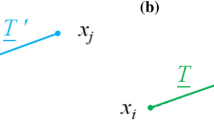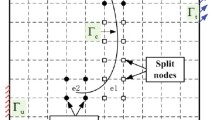Abstract
Notched three-point bend specimens (TPB) were tested under crack mouth opening displacement (CMOD) control at a rate of 0.0004 mm/s and the entire fracture process was simulated using a regular triangular two-dimensional lattice network only over the expected fracture process zone width. The rest of the beam specimen was discretised by a coarse triangular finite element mesh. The discrete grain structure of the concrete was generated assuming the grains to be spherical. The load versus CMOD plots thus simulated agreed reasonably well with the experimental results. Moreover, acoustic emission (AE) hits were recorded during the test and compared with the number of fractured lattice elements. It was found that the cumulative AE hits correlated well with the cumulative fractured lattice elements at all load levels thus providing a useful means for predicting when the micro-cracks form during the fracturing process, both in the pre-peak and in the post-peak regimes.
Similar content being viewed by others
References
Alexander KM, Wardlaw J, Gilbert DJ (1968) Aggregate-cement bond, cement paste strength and strength of concrete. Proceedings of international conference on the structure of concrete, cement and concrete association, pp 59–81
Arslan A, Ince R, Karihaloo BL (2002) Improved lattice model for concrete fracture. J Eng Mech ASCE 128(1): 57–65
Bazant ZP, Planas J (1998) Fracture and size effect in concrete and other quasi brittle materials. CRC press, Boca Raton, FL
Chiaia B, Vervuurt AHJM, van Mier JGM (1997) Lattice model evaluation of progressive failure in disordered particle composites. Eng Frac Mech 57(2/3): 301–318
Herrmann HJ (1991) Patterns and scaling in fracture, in fracture process in concrete, rock and ceramics. In: Van Mier JGM, Rots JG, Bakker A (eds) Chapman & Hall, New York, p 195
Hsu TTC, Slate FO (1963) Tensile bond strength between aggregate and cement paste or mortar. J Am Conc Inst 4(4): 465–485
Ince R (2005) A novel meso-mechanical model for concrete fracture. Str Eng Mech 18(1): 28–36
Ince R, Arslan A, Karihaloo BL (2003) Lattice modeling of size effect in concrete strength. Eng Fract Mech 70: 2307–2320
Karihaloo BL (1995) Fracture mechanics and structural concrete. Addison Wesley, Longman, UK
Karihaloo BL, Shao PF, Xiao QZ (2003) Lattice modeling of the failure of particle composites. Eng Fract Mech 70: 2385–2400
Landis EN, Baillon L (2002) Experiments to relate acoustic emission energy to fracture energy of concrete. J Eng Mech 128(6): 698–702
Maji AK, Ouyang C, Shah SP (1990) Fracture mechanism of quasi-brittle materials based on acoustic emission. J Math Res 5(1): 206–217
Ohtsu M (1996) The history and development of acoustic emission in concrete engineering. Mag Conc Res 48(177): 321–330
Schlangen E, Garboczi EJ (1996) New method for simulating fracture using an elastically uniform random geometry lattice. Int J Eng Sci 34(10): 1131–1144
Schlangen E, Garboczi EJ (1997) Fracture simulations of concrete using lattice models: computational aspects. Eng Fract Mech 57(2/3): 319–332
Schlangen E, Van Mier JGM (1991) Experimental and numerical analysis of micro mechanisms of fracture of cement based composites, report no. 25. 5.-91-1/VFC., TU., Delft
Schlangen E, van Mier JGM (1992a) Experimental and numerical analysis of micromechanicsm of fracture of cement based composites. Cem Conc Comp 14: 105–118
Schlangen E, van Mier JGM (1992b) Simple lattice model for numerical simulation of fracture of concrete materials. Mater Struct 25: 534–542
Schorn H, Rode U (1991) Numerical simulation of crack propagation from micro cracking to fracture. Cem Conc Comp 13: 87–94
Shah SP, Swartz SE, Ouyang C (1995) Fracture mechanics of concrete: applications of fracture mechanics to concrete, rock and other quasi-brittle materials. Wiley, New York
VanMier JGM (1997) Fracture process of concrete: assessment of material parameters for fracture models. CRC press, Boca Raton, FL
Van Vliet MRA (2000) Size effect in tensile fracture of concrete and rock. PhD thesis, Delft University Press, Delft
Walraven JC (1980) Aggregate interlock: a theoretical and experimental analysis. PhD thesis, Delft University of Technology
Author information
Authors and Affiliations
Corresponding author
Rights and permissions
About this article
Cite this article
Vidya Sagar, R., Raghu Prasad, B.K. & Karihaloo, B.L. Verification of the applicability of lattice model to concrete fracture by AE study. Int J Fract 161, 121–129 (2010). https://doi.org/10.1007/s10704-009-9431-7
Received:
Accepted:
Published:
Issue Date:
DOI: https://doi.org/10.1007/s10704-009-9431-7




